
5 Powerful Reasons Quitting Smoking Can Help Reverse Dupuytren’s Damage
Introduction
Most people associate smoking with lung cancer, heart disease, or stroke—but its effects go far beyond the respiratory and cardiovascular systems. Cigarette smoke profoundly alters connective tissue health, impairing the body’s ability to repair and regenerate properly.
Research shows that smokers are two to three times more likely to develop Dupuytren’s contracture, a hand condition characterized by thickened cords under the skin and bent fingers that can limit movement. Moreover, smokers who do develop the condition often experience more severe symptoms and poorer recovery outcomes after treatment.
Understanding how smoking drives fibrosis at the cellular level can help patients make informed choices that support both their hand function and overall tissue health.
How Smoking Affects Connective Tissue
Each cigarette contains thousands of chemicals, many of which are toxic to cells and blood vessels. Nicotine, a major component of tobacco, constricts blood vessels, reducing the flow of oxygen and nutrients to tissues. At the same time, carbon monoxide binds to hemoglobin, displacing oxygen and further limiting tissue oxygenation.
When tissues are deprived of oxygen for long periods, fibroblasts—the cells responsible for producing collagen—enter a stressed, overactive state. These fibroblasts continue generating collagen long after it’s needed, creating excessive and disorganized buildup. Over time, this leads to the stiff, fibrotic cords that define Dupuytren’s contracture.
Fibrosis and Collagen Stiffening
Fibroblasts exposed to tobacco toxins don’t just produce too much collagen—they also create collagen fibers that are denser and less flexible. Normally, collagen provides elasticity and structure, but under the influence of smoking, the fibers become cross-linked and hardened, losing their stretch and adaptability.
This same process explains why smokers tend to heal more slowly after surgery or injury. Blood vessel constriction, poor oxygenation, and abnormal collagen formation make it difficult for the body to close wounds efficiently. For Dupuytren’s patients, that means longer recovery times and an increased risk of complications after procedures such as needle aponeurotomy, collagenase injection, or surgical release.
Scientific Evidence
The link between smoking and Dupuytren’s is backed by large population studies and decades of clinical data. Cohort analyses consistently identify smoking as an independent risk factor, even when accounting for other contributors like age, alcohol use, or genetic predisposition.
The risk increases with both the duration and intensity of smoking—the more years and cigarettes consumed, the greater the likelihood of developing contracture. Additionally, smokers tend to experience earlier onset and faster progression of the disease.
Even after successful treatment, recurrence rates are significantly higher among smokers compared to non-smokers. The underlying tissue remains biochemically altered, making it more prone to fibrosis even after cords are removed or dissolved.
Mechanisms Behind the Damage
Researchers have identified several overlapping biological mechanisms by which smoking drives Dupuytren’s and other fibrotic conditions:
-
Reduced circulation: Nicotine narrows blood vessels, limiting nutrient and oxygen delivery essential for tissue maintenance and repair.
-
Oxidative stress: Tobacco smoke generates free radicals that directly damage connective tissue proteins and cell membranes.
-
Chronic inflammation: Persistent irritation keeps fibroblasts activated, sustaining abnormal collagen production.
-
Collagen stiffening: Chemical byproducts in smoke promote cross-linking between collagen fibers, reducing flexibility and promoting contracture.
Together, these processes create a “perfect storm” for fibrosis—damaging tissues while simultaneously preventing proper healing.
The Systemic Connection
While Dupuytren’s is most visible in the hands, the same biological effects of smoking contribute to fibrosis throughout the body. Research has linked smoking to pulmonary fibrosis, liver fibrosis, and vascular stiffening, suggesting that the hand may serve as a visible warning sign of deeper systemic damage.
This broader connection underscores why addressing smoking is crucial not only for hand health but for overall connective tissue integrity across organs.
Why Quitting Matters
Although quitting smoking cannot reverse existing Dupuytren’s cords, it can slow progression, improve circulation, and enhance treatment outcomes. Within weeks of quitting, blood flow and tissue oxygenation begin to recover, reducing fibroblast overactivity and helping tissues repair more effectively.
Patients who stop smoking before undergoing surgery or injection therapy tend to heal faster, experience fewer infections, and enjoy better long-term hand flexibility. Over time, they also report fewer new nodules and slower recurrence of contracture.
Conclusion
Smoking fuels the very biological mechanisms that drive Dupuytren’s contracture—fibrosis, inflammation, and poor healing. But the good news is that quitting remains one of the most powerful and immediate steps patients can take to protect their connective tissue.
Every cigarette avoided helps restore oxygen flow, calm inflammation, and support natural healing processes. By breaking the link between smoking and fibrosis, patients not only safeguard their hands but also their overall health and longevity.
Legal & Medical Disclaimer
This content is for informational and educational purposes only and is not a substitute for professional medical advice, diagnosis, or treatment. Always consult your healthcare provider about any medical concerns or treatment options. Dupuytren’s Solutions is an educational resource meant to be used alongside, not instead of, professional care, and individual results may vary.
Call to Action
Learn about lifestyle risks and Dupuytren’s prevention at DupuytrensSolutions.com. Join our support community for encouragement and success stories: facebook.com/groups/dupuytrenssolutionsandhealth.
Attribution
(CC BY 2.0) Adapted from Bayat A et al. Alcohol and Dupuytren’s Contracture. J Hand Surg Br. 2006; 31(6): 581–586. Licensed under Creative Commons Attribution 2.0. For the complete article and reference list, click Source.






